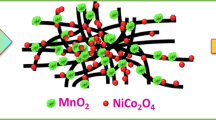Abstract
The manganese oxide/multi-walled carbon nanotube (MnO2/MWNT) composite and the manganese oxide/acetylene black (MnO2/AB) composite were prepared by translating potassium permanganate into MnO2 which formed the above composite with residual carbon material using the redox deposition method and carbon as a reducer. The products were characterized by X-ray diffraction, Fourier transform infrared, and scanning electron microscope. Electrochemical properties of both the MnO2/MWNT and MnO2/AB electrodes were studied by using cyclic voltammetry, electrochemical impedance measurement, and galvanostatic charge/discharge tests. The results show that the MnO2/MWNT electrode has better electrochemical capacitance performance than the MnO2/AB electrode. The charge–discharge test showed the specific capacitance of 182.3 F·g−1 for the MnO2/MWNT electrode, and the specific capacitance of 127.2 F·g−1 for the MnO2/AB electrode had obtained, within potential range of 0–1 V at a charge/discharge current density of 200 mA·g−1 in 0.5 mol·L−1 potassium sulfate electrolyte solution in the first cycle. The specific capacitance of both the MnO2/MWNT and MnO2/AB electrodes were 141.2 F·g−1 and 78.5 F·g−1 after 1,200 cycles, respectively. The MnO2/MWNT electrode has better cycling performance. The effect of different morphologies was investigated for both MnO2/MWNT and MnO2/AB composites.








Similar content being viewed by others
References
An KH, Kim WS, Park YS, Choi YC, Lee SM, Chung DC, Bae DJ, Lim SC, Lee YH (2001) Supercapacitors using single-walled carbon nanotube electrodes. Adv Mater 13:497–500
Lee JK, Pathan HM, Jung KD, Joo OS (2006) Electrochemical capacitance of nanocomposite films formed by loading carbon nanotubes with ruthenium oxide. J Power Sources 159:1527–1531
Kibi Y, Saito T, Kurata M, Tabuchi J, Ochi A (1996) Fabrication of high-power electric double-layer capacitors. J Power Sources 60:219–224
Kudo T, Ikeda Y, Watanabe T, Hibino M, Miyayama M, Abe H, Kajita K (2002) Amorphous V2O5/carbon composites as electrochemical supercapacitor electrodes. Solid State Ionics 152–153:833–841
Pekala RW (1989) Organic aerogels from the polycondensation of resorcinol with formaldehyde. J Mater Sci 24:3221–3227
Chen Y, Zhang ML, Shi ZH (2005) Electrochemical and capacitance properties of rod-shaped MnO2 for supercapacitor. J Electrochem Soc 152:A1272–A1278
Subramanian V, Zhu HW, Wei BQ (2006) Nanostructured MnO2: hydrothermal synthesis and electrochemical properties as a supercapacitor electrode material. J Power Sources 159:361–364
Zheng JP, Cygan PJ, Jow TR (1995) Hydrous ruthenium oxide as an electrode material for electrochemical capacitors. J Electrochem Soc 142:2699–2703
Hea XJ, Genga YJ, Oke S, Higashi K, Yamamoto M, Takikawa H (2009) Electrochemical performance of RuOx/activated carbon black composite for supercapacitors. Synthetic Met 159:7–12
Kim HK, Seong TY, Lim JH, Cho WI, Yoon YS (2001) Electrochemical and structural properties of radio frequency sputtered cobalt oxide electrodes for thin-film supercapacitors. J Power Sources 102:167–171
Patil UM, Salunkhe RR, Gurav KV, Lokhande CD (2008) Chemically deposited nanocrystalline NiO thin films for supercapacitor application. Appl Surf Sci 255:2603–2607
Wang DW, Li F, Cheng HM (2008) Hierarchical porous nickel oxide and carbon as electrode materials for asymmetric supercapacitor. J Power Sources 185:1563–1568
Wu NL (2002) Nanocrystalline oxide supercapacitors. Mater Chem Phys 75:6–11
Reddy RN, Reddy RG (2003) Sol–gel MnO2 as an electrode material for electrochemical capacitors. J Power Sources 124:330–337
Xu MW, Zhao DD, Bao SJ, Li HL (2007) Mesoporous amorphous MnO2 as electrode material for supercapacitor. J Solid State Electrochem 11:1101–1107
Sharma RK, Oh HS, Shul YG, Kim H (2007) Carbon-supported, nano-structured, manganese oxide composite electrode for electrochemical supercapacitor. J Power Sources 173:1024–1028
Hu CC, Tsou TW (2003) The optimization of specific capacitance of amorphous manganese oxide for electrochemical supercapacitors using experimental strategies. J Power Sources 115:179–186
Yuan AB, Zhang QL (2006) A novel hybrid manganese dioxide/activatedcarbon supercapacitor using lithium hydroxide electrolyte. Electrochem Commun 8:1173–1178
Abou-El-Sherbini KhS, Askar MH (2002) Hydrated layered manganesedioxide: Part II. Electrochemical behaviour of some hydrated layered manganese dioxides in alkaline electrolytes. Solid State Ionics 150:417–430
Hu CC, Wang CC (2002) Improving the utilization of ruthenium oxide within thick carbon–ruthenium oxide composites by annealing and anodizing for electrochemical supercapacitors. Electrochem Commun 4:554–559
Acknowledgement
The authors acknowledge the financial support from the National Natural Science Foundation of China (number is 20701029). The authors gratefully acknowledge the helps of Mam X.Y. Zhang and Mr. X.Y. Ji, Analytical and Testing Center at Sichuan University, for the SEM micrographs and the XRD patterns.
Author information
Authors and Affiliations
Corresponding author
Rights and permissions
About this article
Cite this article
Chu, HY., Lai, QY., Wang, L. et al. Preparation of MnO2/WMNT composite and MnO2/AB composite by redox deposition method and its comparative study as supercapacitive materials. Ionics 16, 233–238 (2010). https://doi.org/10.1007/s11581-009-0378-5
Received:
Revised:
Accepted:
Published:
Issue Date:
DOI: https://doi.org/10.1007/s11581-009-0378-5




